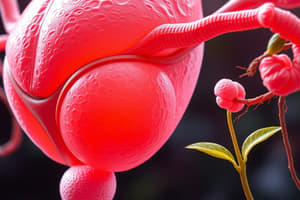Podcast
Questions and Answers
What is the primary distinction between growth and development in biological terms?
What is the primary distinction between growth and development in biological terms?
- Growth is an increase in size, whereas development involves structural and functional changes. (correct)
- Development refers to an increase in size and mass.
- Development can occur without any genetic influence.
- Growth involves changes in structure and function.
Which factor does NOT influence growth in organisms?
Which factor does NOT influence growth in organisms?
- Temperature
- Nutrition
- Color of the organism (correct)
- Hormones
What type of reproduction results in offspring that are genetically identical to the parent?
What type of reproduction results in offspring that are genetically identical to the parent?
- Sexual reproduction
- Both B and C (correct)
- Budding
- Binary fission
Which component of photosynthesis is responsible for capturing light energy?
Which component of photosynthesis is responsible for capturing light energy?
What is the main importance of sexual reproduction in organisms?
What is the main importance of sexual reproduction in organisms?
In which part of the plant cell does photosynthesis primarily take place?
In which part of the plant cell does photosynthesis primarily take place?
What is the primary purpose of cellular respiration?
What is the primary purpose of cellular respiration?
What distinguishes aerobic respiration from anaerobic respiration?
What distinguishes aerobic respiration from anaerobic respiration?
Which type of nutrition involves organisms that produce their own food?
Which type of nutrition involves organisms that produce their own food?
Which of the following is NOT an essential nutrient for organisms?
Which of the following is NOT an essential nutrient for organisms?
Flashcards are hidden until you start studying
Study Notes
Growth and Development
- Definition: Growth refers to an increase in size and mass, while development involves changes in structure and function over time.
- Stages: Typically includes embryonic, juvenile, and adult stages.
- Factors Influencing Growth:
- Genetics
- Environment (nutrition, temperature)
- Hormones (e.g., growth hormone)
Reproduction
- Definition: The biological process by which new individual organisms are produced.
- Types:
- Asexual Reproduction: Involves a single parent; offspring are genetically identical (e.g., binary fission, budding).
- Sexual Reproduction: Involves two parents; offspring have genetic variation (e.g., fertilization).
- Importance: Ensures species survival, genetic diversity, and adaptation.
Photosynthesis
- Definition: The process by which green plants, algae, and some bacteria convert light energy into chemical energy.
- Equation:
- Carbon dioxide + Water + Light energy → Glucose + Oxygen
- Key Components:
- Chlorophyll: Pigment that captures light energy.
- Location: Occurs in chloroplasts of plant cells.
- Importance: Provides oxygen and organic compounds for ecosystems.
Nutrition
- Definition: The process by which organisms obtain and utilize food for energy, growth, and maintenance.
- Types:
- Autotrophic Nutrition: Organisms produce their own food (e.g., plants via photosynthesis).
- Heterotrophic Nutrition: Organisms consume other organisms (e.g., animals).
- Essential Nutrients: Carbohydrates, proteins, fats, vitamins, and minerals.
Cellular Respiration
- Definition: The metabolic process by which cells convert biochemical energy from nutrients into ATP, releasing waste products.
- Types:
- Aerobic Respiration: Requires oxygen; produces more ATP.
- Anaerobic Respiration: Occurs without oxygen; produces less ATP (e.g., fermentation).
- Equation for Aerobic Respiration:
- Glucose + Oxygen → Carbon dioxide + Water + ATP
Respiration
- Definition: The biochemical process of exchanging gases; involves inhalation of oxygen and exhalation of carbon dioxide.
- Types:
- External Respiration: Exchange of gases between the organism and its environment.
- Internal Respiration: Exchange of gases at the cellular level within tissues.
- Importance: Supplies oxygen for cellular respiration and removes carbon dioxide waste.
Growth and Development
- Growth indicates an increase in physical size and mass, while development refers to structural and functional changes over time.
- Common stages of development include embryonic, juvenile, and adult phases.
- Key factors influencing growth include genetics, environmental conditions (nutrition, temperature), and hormones such as growth hormone.
Reproduction
- Reproduction is the biological mechanism for producing new individual organisms.
- Asexual reproduction involves one parent and results in genetically identical offspring, with methods such as binary fission and budding.
- Sexual reproduction requires two parents, resulting in offspring with genetic variation and involves processes like fertilization.
- Reproduction is crucial for species survival, contributing to genetic diversity and adaptation.
Photosynthesis
- Photosynthesis is the process through which green plants, algae, and certain bacteria convert light energy into chemical energy.
- The fundamental equation is: Carbon dioxide + Water + Light energy → Glucose + Oxygen.
- Chlorophyll is the pigment responsible for capturing light energy and is located in the chloroplasts of plant cells.
- This process is vital for ecosystems as it produces oxygen and organic compounds.
Nutrition
- Nutrition involves how organisms acquire and utilize food for energy, growth, and maintenance.
- Autotrophic nutrition allows organisms, like plants, to produce their own food through processes like photosynthesis.
- Heterotrophic nutrition describes organisms, such as animals, that consume other organisms for food.
- Essential nutrients include carbohydrates, proteins, fats, vitamins, and minerals, necessary for various bodily functions.
Cellular Respiration
- Cellular respiration is the metabolic process that converts biochemical energy from nutrients into ATP while releasing waste products.
- Aerobic respiration necessitates oxygen and yields more ATP, whereas anaerobic respiration occurs without oxygen and produces less ATP, as seen in fermentation.
- The equation for aerobic respiration is: Glucose + Oxygen → Carbon dioxide + Water + ATP.
Respiration
- Respiration is the biochemical process involving gas exchange, characterized by the inhalation of oxygen and the exhalation of carbon dioxide.
- External respiration refers to the gas exchange between the organism and its environment.
- Internal respiration involves the exchange of gases at the cellular level within tissues.
- This process is essential for supplying oxygen for cellular respiration and expelling carbon dioxide waste.
Studying That Suits You
Use AI to generate personalized quizzes and flashcards to suit your learning preferences.




